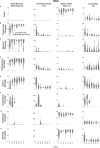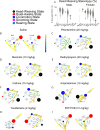Sex-specific effects of appetite suppressants on stereotypy in rats
- PMID: 40554466
- PMCID: PMC12186957
- DOI: 10.1371/journal.pone.0325067
Sex-specific effects of appetite suppressants on stereotypy in rats
Abstract
This study investigated the sex-specific effects of commonly prescribed appetite suppressants on body weight and the manifestation of motor side effects, specifically stereotypy. Employing video recordings and DeepLabCut (DLC) for precise behavioral quantification, we analyzed stereotypy, defined as purposeless, repetitive motor behaviors, in male and female rats. Under control (saline) conditions, male rats exhibited a greater propensity for weight gain compared to females. However, in contrast, female rats demonstrated greater and more homogenous weight loss than males following the administration of diethylpropion and tesofensine. Phentermine and mazindol induced comparable weight loss in both sexes, whereas cathine elicited weight reduction exclusively in males. 5-HTP and d-amphetamine administration only prevented weight gain relative to controls. Analysis of motor side effects revealed that drugs primarily targeting dopamine pathways - specifically, phentermine, mazindol, diethylpropion, cathine, and d-amphetamine - induced pronounced stereotypies, particularly head-weaving, in both sexes. Interestingly, tesofensine elicited head-weaving behavior exclusively in female subjects, albeit to a lesser extent than that observed with other dopaminergic agents; conversely, tesofensine was most frequently associated with orolingual dyskinesia. Male subjects treated with these same drugs exhibited an unexpected effect: spontaneous ejaculations, potentially attributable to the combined effects on dopamine and serotonin signaling in brain regions regulating sexual function. Network analysis and Markov transition matrices revealed distinct behavioral profiles associated with head-weaving, which emerged as the dominant attractor state, suggesting potential mechanistic differences among these drugs. Collectively, this study provides a valuable database characterizing the behavioral side effects of appetite suppressants.
Copyright: © 2025 Lopez et al. This is an open access article distributed under the terms of the Creative Commons Attribution License, which permits unrestricted use, distribution, and reproduction in any medium, provided the original author and source are credited.
Conflict of interest statement
The authors have declared that no competing interests exist.
Figures






Similar articles
-
Sertindole for schizophrenia.Cochrane Database Syst Rev. 2005 Jul 20;2005(3):CD001715. doi: 10.1002/14651858.CD001715.pub2. Cochrane Database Syst Rev. 2005. PMID: 16034864 Free PMC article.
-
Systemic pharmacological treatments for chronic plaque psoriasis: a network meta-analysis.Cochrane Database Syst Rev. 2021 Apr 19;4(4):CD011535. doi: 10.1002/14651858.CD011535.pub4. Cochrane Database Syst Rev. 2021. Update in: Cochrane Database Syst Rev. 2022 May 23;5:CD011535. doi: 10.1002/14651858.CD011535.pub5. PMID: 33871055 Free PMC article. Updated.
-
Drugs for preventing postoperative nausea and vomiting in adults after general anaesthesia: a network meta-analysis.Cochrane Database Syst Rev. 2020 Oct 19;10(10):CD012859. doi: 10.1002/14651858.CD012859.pub2. Cochrane Database Syst Rev. 2020. PMID: 33075160 Free PMC article.
-
Behavioral interventions to reduce risk for sexual transmission of HIV among men who have sex with men.Cochrane Database Syst Rev. 2008 Jul 16;(3):CD001230. doi: 10.1002/14651858.CD001230.pub2. Cochrane Database Syst Rev. 2008. PMID: 18646068
-
Antidepressants for pain management in adults with chronic pain: a network meta-analysis.Health Technol Assess. 2024 Oct;28(62):1-155. doi: 10.3310/MKRT2948. Health Technol Assess. 2024. PMID: 39367772 Free PMC article.
References
-
- Twohig MP, Varra EM. Treatment of drug-induced stereotypy. Behav Anal Today. 2006;7(2):206–11. doi: 10.1037/h0100081 - DOI
MeSH terms
Substances
LinkOut - more resources
Full Text Sources

